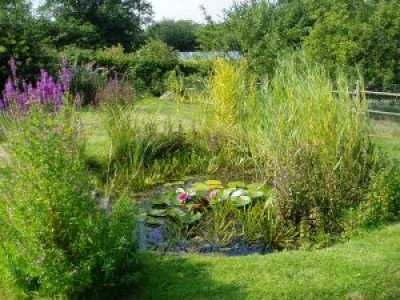Garden Pond Survey 2006
The April 2006 number of the Woodcote Correspondent contained a questionnaire on garden ponds in Woodcote, which resulted in responses from 31 households. Of these, five reported that they had no garden pond. The remainder provided valuable detailed information on their ponds, of which the following is a summary.

1. Natural or artificial? All the respondents with ponds in their gardens categorised them as ‘artificial’. Of the various pond-lining materials mentioned (butyl, fibreglass, concrete, plastic) butyl was the commonest, making up half of the total. Only one respondent described their pond lining as ‘natural’.
2. Size The ponds reported divided evenly into the three size categories: about a third were less than 1.5 metres across; another third 1.5 to 2.5 metres; and the remainder were more than 2.5 metres across.
3. Level variation Half of respondents said their ponds changed in level over the year. Just over 60% topped their ponds up, and nearly half said they used tap water for this. (Perfectly legal, incidentally, under the provisions of the ‘hose-pipe ban’!)
4. Fish Nearly half of respondents said that they kept fish in their ponds. Goldfish were by far the commonest (and also the most numerous: one pond contained 40, and another 25), followed by orfe and koi (2 ponds each); one owner also reported 6 shubunkin, and another one 5 rudd.
5. Native pond creatures Frogs were the most commonly and frequently observed, with half of the respondents noting that they were ‘present most of the year’. About half also reported that frogs bred in their ponds (although in one case the frogspawn was eaten up within a few days by a pair of mallard who flew in for half an hour or so early each morning; another respondent reported that a sparrowhawk was taking frogs from their pond, and in another case carrion crows were catching the tadpoles). There was a striking inverse relationship between fish and frogs: of the 12 ponds reported as containing fish, only 3 had frogspawn, whereas of the 14 recorded as having no fish, 8 had frogspawn. Both toads and newts were observed in about a third of ponds, but there was only one record each of toadspawn and newtspawn (very probably because their spawn is much less obvious than frogspawn). Three respondents named the actual species of newt in their pond: in all three of these cases common (smooth) newts were present, alongside – in one of the ponds – great crested newts, and – in the other – palmate newts. As for insects, two thirds reported regularly seeing dragonflies, and about a third also saw damselflies. Other creatures mentioned included leeches, water boatmen, pond skaters, water snails (both ramshorn and ‘common’), and an ‘occasional grass snake’.
6. Birds and mammals In addition to common garden birds, seven respondents mentioned herons (with one reporting that ‘herons have taken all the fish’); three more mentioned mallard, and one reported a breeding pair of moorhens. Of the mammals mentioned, the commonest were hedgehog and grey squirrel; bats were also observed hunting over garden ponds by two respondents.
7. Plants Marginal, floating, and submerged plants were all mentioned. The first category was the most frequent, and included sedges, rushes, reedmace, irises, marsh marigold, watermint, great willowherb, and water forget-me-not. Water soldier and duckweed were the two floating plants mentioned, and hornwort and Canadian pondweed were named as ‘oxygenators’. Seven respondents also mentioned that their ponds contained water lilies.
8. ‘Lost ponds’ There were a number of reports of old ‘non-garden’ ponds that have disappeared from Woodcote. Most of these were on the Greenmoor side of the village, and were listed as follows by one particularly knowledgeable long-term resident of the village:
– top of Greenmoor Hill opposite Black Lion;
– opposite Spen Cottage;
– Grimmer Way old field;
– Greenmoor Hill Farm;
– opposite Wards Farm;
– bottom of Greenmoor on Oratory grounds. (Half of this latter one survives in the shape of the pond across the road, which is now fed by run-off; formerly Greenmoor Hill was a farm track with a ford across a much larger pond at the bottom, of which the present pond is a remnant.)
Intriguingly, these ponds run in a line across the map which can be seen to continue with Tidmore Pool, and the Waterfield and Wimblefield ponds across the bypass.
Another lost pond reported was on South Stoke Road, next to James Farm, and in addition a lost garden pond was reported from Beech Lane.
(This survey was conducted in cooperation with Pond Conservation. For further details of their activities and publications, click here.
